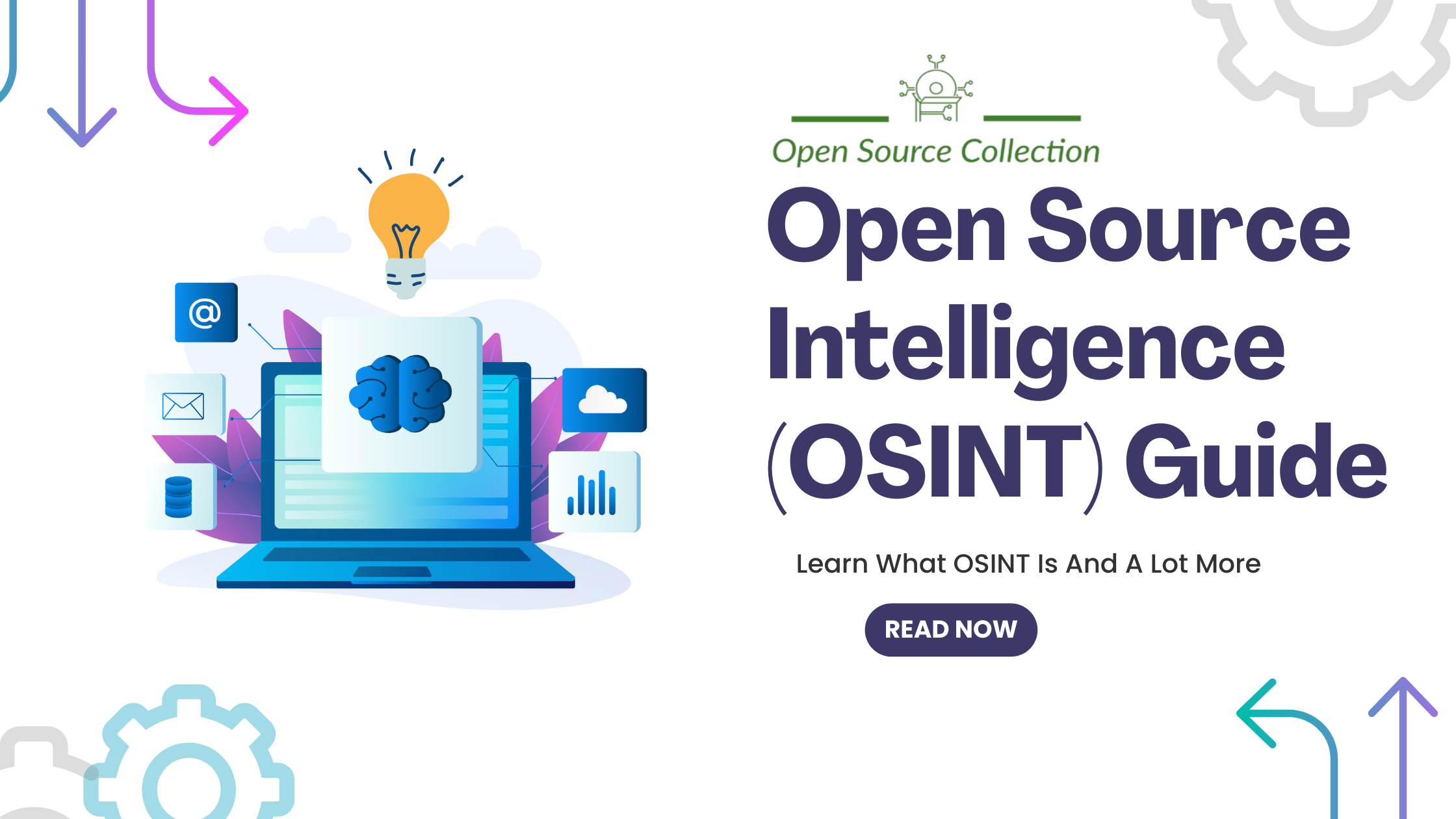OSINT (open-source intelligence) is an affordable and accessible method of providing enterprise cybersecurity management and other business intelligence.
This form of intelligence is collected from the different sources on the internet. This makes the information very detailed, but it is also a huge amount of data that has to be carefully checked to ensure its accuracy.
In this guide you will find, what is open-source intelligence and what are its features, what are benefits, and a lot more. So let’s start reading and find out!
A little About Open Source Intelligence (OSINT)

Web intelligence, also referred to as open-source intelligence (OSINT), is the process of accumulating, analyzing, and distributing information available to the public through the Internet. Areas of application for OSINT include research, investigation, journalism and also security; business as well as education.
With the help of OSINT, you can unveil many important insights and also information that are sometimes very difficult to find through conventional search engines or even databases. It assists in the discovery of many hidden relations, detecting patterns and trends, identifying threats as well as fact-checking.
But applying OSINT also bears many risks and difficulties. However, it is very essential to consider the ethical, legal, and also security aspects of OSINT. You also require proper tools, skills, and methods to perform OSINT effectively.
The Different Types Of OSINT
Here are five prominent types of Open-Source Intelligence (OSINT):
-
Web OSINT: Involves scraping information from the websites, message boards, and blogs created on the web. This kind of concerns free data on the Internet.
-
Social Media OSINT: Focuses on collecting intelligence from social media sites such as Facebook, Twitter, Instagram, or LinkedIn among many others. It includes the user profile, post, connections, and also interaction analysis.
-
Geospatial OSINT: It deals with the analysis and interpretation of information in a geographic format. This can be satellite imagery, maps, and any geospatial data to distill intelligence out of them.
-
Cyber OSINT: It describes the activities related to gathering information on cybersecurity, e.g., detecting vulnerabilities, monitoring threat actors, and potential cyber threats identification. It includes data analysis from the virtual world.
-
Dark Web OSINT: Consists of surveillance and data gathering from the dark web, a large portion of the internet that does not appear in search engines. Dark Web OSINT is aimed at detecting information concerning illegal activities, cyber dangers, and also underground forums.
These kinds of OSINT produce a wide range of intelligence encompassing different facets, ranging from the online and digital world. However, according to the purpose of intelligence gathering, one or more types may be preferred by individuals or organizations.
How Open Source Intelligence Works?
If you want to tap into open source intelligence (OSINT), a simple way to start is by using a search engine. For example, you can Google "What is eWeek." Asking the right questions about the information you need is crucial in finding relevant data entries that can lead to more details.
Beyond general internet searches, you can narrow down your focus to specific platforms like social media. Experienced users might also analyze threat intelligence feeds that constantly update vast amounts of data.
When dealing with large data sources like databases or data lakes, manual searches are inefficient. In such cases, investing in a web scraping tool or a specialized OSINT tool can automate and speed up the data analysis process, making it quicker and more effective.
Passive vs. Active OSINT- Collection Methods
Passive and active OSINT are both very effective in collecting open source intelligence, with varying requirements of engaging activity as well as elaborated research.

By using a passive form of OSINT, users typically run through simple search engines, social media, or file searches and often just access the entry home page for webpages or news sites. They don’t actively try to gather precise information, but they are simply passively looking at the easiest-to-get surface or top-of-the-stack intelligence that is easily available. This form of intelligence collection is aimed at gathering significant information while keeping the targets or data sources unaware that it’s being done on them.
In active OSINT the methods are much alot more invasive and also involved. In more complex queries, the users can obtain obscure intelligence and metadata from the databases and network infrastructures. They might as well complete a form, or pay for the removal of the paywall to know more.
In some instances, active OSINT may even include contacting the sources for extra information that is not present or observable in public. In contrast to passive OSINT, whose information tends to be very specific and timely, active OSINT is almost impossible to carry out undercover but can easily land you in legal quandaries when using such data collection techniques is not well thought of.
Open Source Intelligence (OSINT)- Pros And Cons
Here we are sharing some of the important pros and cons of this intelligence! That will help you understand this intelligence better…
Pros of Open Source Intelligence (OSINT):
-
Enhanced Cyber Defenses: OSINT helps improve cybersecurity by identifying and addressing potential risks, and providing a better understanding of common attack methods. It allows organizations to respond effectively to cyber threats.
-
Affordable and Accessible Tools: OSINT tools are often free and easily accessible, making them available to a wide range of users. This affordability democratizes access to valuable data sources.
-
Democratized Data Collection: You don't need advanced technical skills to benefit from OSINT. It opens up valuable data to a broader audience, allowing non-experts to access and use publicly available information.
-
Quick and Scalable Data Collection: OSINT offers fast and scalable methods for gathering relevant information. Various passive and active data sourcing techniques allow for quick and efficient results at scale.
-
Compatibility with Cybersecurity Programs: OSINT data integrates well with existing cybersecurity tools and programs. While it might not provide all the needed information alone, it complements other data sources effectively.
Cons of Open Source Intelligence (OSINT):
-
Accessible to Bad Actors: The same accessibility that benefits organizations also applies to malicious actors. Hackers can use OSINT to identify vulnerabilities and potential attack points.
-
Limitations and Inaccuracies: Public information lacks thorough fact-checking, leading to potential inaccuracies. Conflicting or outdated information from various sources can introduce errors in research.
-
User Error and Phishing: Individuals may unintentionally expose sensitive information through public sources, especially if they fall victim to phishing attacks. This turns private data into public information.
-
Massive Data to Process: Dealing with vast amounts of data from databases, websites, and social media platforms can be challenging. Continuous growth and changes in data make it difficult to sift through and identify crucial intelligence.
-
Ethical and Privacy Concerns: OSINT activities often occur without the target's knowledge, raising ethical concerns. If personal or health information is unintentionally exposed, it can be misused, potentially harming or manipulating individuals.
Also Read: Open Source Technologies and Why You Should Learn Them
OSINT Use Cases
Ever searched for someone on Facebook or Googled your family's last name? That's a basic way people use open-source intelligence (OSINT) in their everyday lives. Businesses also unknowingly use OSINT, often for a competitive advantage. Here are some common uses:
1. Threat Intelligence and Security: OSINT helps security professionals understand threats better. It provides a broad view of the threat landscape, details on potential attackers, and historical data on past vulnerabilities and attacks.
2. Market Research and Brand Monitoring: OSINT is used to gather info on consumer behavior and brand perception. Businesses look into social media, forums, customer relationship management (CRM) systems, and chat logs for insights.
3. Competitive Analysis: Similar to brand monitoring, OSINT can be used to study competitors. It helps businesses understand how well their rivals are doing in the eyes of customers.
4. Geolocation Data Analysis: OSINT helps find and verify locations using publicly available data related to images and videos.
5. Real-time Demographic Analyses: During major events like elections or disasters, OSINT reviews social media and forum posts to gauge public sentiment and identify areas needing support.
6. Background Checks and Law Enforcement: While law enforcement primarily uses closed-source intelligence, OSINT fills in gaps. Civilians may use it for background checks within legal limits.
7. Fact-Checking: Journalists and researchers use OSINT to quickly verify information from multiple sources, especially in situations with conflicting or contentious details.
Who Can Benefit from OSINT?

Open Source Intelligence (OSINT) is useful for various groups with different motivations. Here's a brief overview:
Government:
Why? Governments, especially military departments, use OSINT for national security, counterterrorism, cybertracking, and understanding public opinions. It helps policymakers make informed decisions and translates foreign media events.
International Organizations:
Organizations like the UN and humanitarian groups use OSINT for peacekeeping and relief efforts. It aids in predicting terrorist actions and protecting supply chains.
Law Enforcement:
Police use OSINT to prevent crimes like abuse, violence, and identity theft. Monitoring social media helps identify potential threats and intervene before crimes escalate.
Businesses:
Businesses leverage OSINT to explore new markets, monitor competitors, plan marketing activities, and predict factors affecting their operations. It's crucial for cybersecurity strategies, data protection, and threat intelligence.
Cybersecurity and Cybercrime Groups:
Hackers and penetration testers use OSINT to gather intelligence about specific targets. It's a valuable tool for conducting social engineering attacks and is a crucial phase in penetration testing.
Privacy-Conscious Individuals:
Ordinary people use OSINT to understand their online exposure, secure their devices, and safeguard against identity theft. It helps maintain digital privacy by revealing how one's online identity appears to outsiders.
Terrorist Groups:
Unfortunately, terrorists use OSINT for planning attacks, gathering information about targets, grooming fighters through social media, acquiring military information, and spreading propaganda.
Best Practices and Tips for OSINT
Using Open Source Intelligence (OSINT) to find information on the internet can be powerful, but it requires some skills and caution. Here are some simple tips:
-
Know what you want to achieve with OSINT. Clearly state your objectives and questions to avoid wasting time on irrelevant information.
-
Don't rely on one source or tool. Use various ones to cross-check and verify information. This helps ensure accuracy and completeness in your research.
Final Thoughts
In this article, I've tried to explain what OSINT is, the different types, who uses it, and how it's used by different groups to gather information. Starting with open-source intelligence can be as easy as doing a Google search about certain parties. It can also be more complicated, like going through a big database with lots of information on different topics.
Whether you choose a simple or more complex approach, it's important that everyone in your team knows your goals for using open-source intelligence. More importantly, they should know how to collect this information in a fair and ethical way.
FAQS
Open-source intelligence (OSINT) itself is legal. Unlawful methods, such as hacking or unauthorized access, can make OSINT activities illegal. Always ensure compliance with relevant laws and ethical standards when conducting OSINT.
Open-source intelligence (OSINT) methodology involves the systematic collection and analysis of information from publicly available sources on the internet. It typically includes tasks like conducting online searches, analyzing social media, exploring websites, and utilizing various tools to gather intelligence. The goal is to obtain valuable insights for decision-making and understanding a particular subject or situation.
The five steps of OSINT (Open Source Intelligence) typically involve:
-
Define Objectives: Clearly outline what information you are seeking and the goals of your OSINT efforts.
-
Collection: Gather information from diverse and relevant sources using various methods.
-
Processing: Organize and analyze the collected data to extract meaningful insights.
-
Analysis: Evaluate the information to draw conclusions and make informed decisions.
-
Dissemination: Share the findings with the intended audience or use the intelligence for decision-making.
The method of OSINT (Open Source Intelligence) involves systematically collecting and analyzing information from publicly available sources on the internet to gain valuable insights. This includes tasks such as online searches, social media analysis, website exploration, and using various tools for intelligence-gathering.

